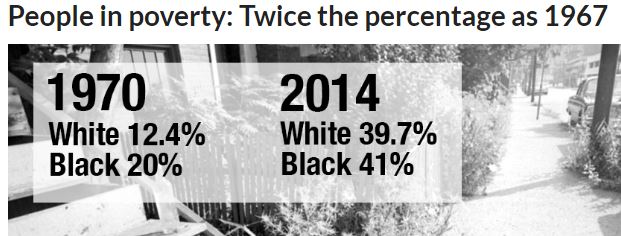The Intersection: The Timeline of Poverty
DJC reporters chronicled poverty, jobs as issues in Detroit since 1967.


Understanding Detroit’s poverty and employment rates is enhanced by looking to the past and by visiting one of the city’s poorest areas today. Bill McGraw, staff writer at Bridge Magazine, and Lester Graham, reporter at Michigan Radio, join host Stephen Henderson on Detroit Today to do that.
The duo are part of the Detroit Journalism Cooperative, a project involving WDET and four other non-profit media partners. In a project called “The Intersection,” the DJC is examining what’s happened since the “Kerner Commission” issued its 1968 report finding America was moving toward two societies, “separate and unequal” between whites and African Americans.
The project is finding that to be the case today, in some ways more separate and more unequal. McGraw developed a timeline of key events and issues related to Detroit’s history and the issues.
“In 1967, things were doing pretty well in Detroit relative to the 50s. The 50s were a decade of great jobs dislocation in Detroit,” McGraw says. “Even African Americans were doing relatively well, relative to white people. … Detroit was a fairly decent place to live.”

The automotive industry provided many fairly well-paying jobs. “They weren’t always great jobs, but they were jobs,” McGraw says.
Even before the 1967 civil unrest, the locations of those jobs were changing and moving from the city. “There has been a clear movement of jobs out of Detroit,” McGraw says. “A lot of those were really well-paying jobs that moved to the suburbs or outside of the state.”
Graham’s visit to the Chandler Park neighborhood found the location of jobs to be one of the biggest challenges to people living in that neighborhood. According to the U.S. Census, the east side neighborhood is the city’s poorest.
Graham talked with residents there, and many of them identified transportation as the biggest challenge to employment. With few jobs in the neighborhood and less-than-ideal mass transit, finding and getting to work is a problem. Graham says the Detroit bus system has improved, but not enough.
“It’s doing better, you have to concede that, but employers say they can’t rely on it,” he says.
A strip mall at Warren Avenue and Conner Street would seem to offer some opportunities, but Graham said residents from nearby neighborhoods are not getting hired at the businesses there.
“The people from out of town are coming to shop at the strip mall. The people across the street can’t get jobs there,” Graham says. “They feel stuck. They feel very frustrated.”
The Kerner Commission identified many issues related to jobs and employment, some of which proved to be predictions of today’s society. But it wasn’t complete. “What the Kerner Commission didn’t anticipate was the change in global capitalism, the huge change in de-industrialization that took place in Detroit and many other major cities,” McGraw says.

The Kerner Report also proposed programs and policies that could help.
“Those solutions…were never even tried and we were left with whatever (President Lyndon) Johnson was able to accomplish at the time and whatever civil rights act we were able to amend later,” Graham says.
